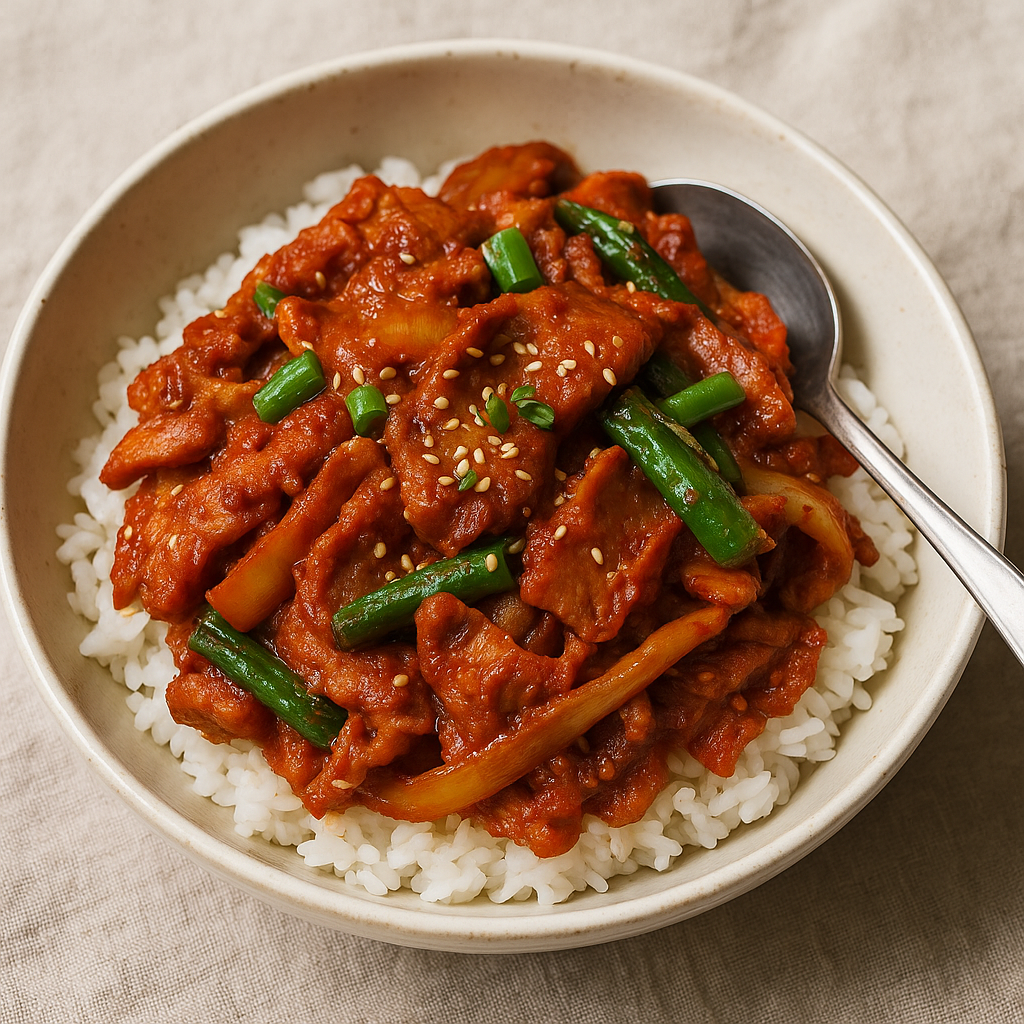Hot Pork (Korean spicy stir-fried pork)
Sweet Heat, Sizzling Pork, and a Bowl of Rice

A bold, spicy-sweet pork stir-fry that hits all the right notes—hot, tender, and deeply satisfying.
Jeyuk bokkeum (제육볶음) is one of those dishes that fills the kitchen with heat, garlic, and caramelizing edges. The flavor is loud in the best way: rich gochujang, just enough sweetness from sugar and onion, and a finish that feels balanced and full when paired with soft rice.
This version leans bold—plenty of sauce, a little extra heat, and a texture that’s sticky, seared, and deeply savory. Scoop it over warm rice or wrap it in lettuce with a little ssamjang. It comes together fast and feeds that craving for something hot and real.
Bowl of Rice, and Pork That Brings the Heat
This spicy-sweet pork stir-fry brings bold flavor with gochujang, garlic, and caramelized edges. Jeyuk bokkeum sizzles in the pan and lands hot over soft rice or tucked into lettuce wraps. It’s fast, fiery, and full of that deep, savory-sweet burn you keep coming back to.
Ingredients:
- 1 to 1½ lb pork shoulder or pork belly, thinly sliced
- ½ onion, sliced
- 2 green onions, cut into 2-inch pieces
- 1 tablespoon oil (for cooking)
- Optional: a handful of cabbage, thinly sliced
- Optional: 1 small carrot, julienned or thinly sliced
- Optional: 1 hot pepper (like jalapeño), thinly sliced—for extra heat
For the marinade:
- 3 tablespoons gochujang (Korean red pepper paste)
- 2 tablespoons gochugaru (Korean red pepper flakes)
- 2 tablespoons sugar
- 1 tablespoon soy sauce
- 1 tablespoon mirin (or rice wine)
- 1 tablespoon sesame oil
- 3 cloves garlic, minced
- 1 teaspoon grated ginger (optional)
- Freshly ground black pepper, to taste
Instructions:
1. Marinate the pork:
In a bowl, stir together the gochujang, gochugaru, sugar, soy sauce, mirin, sesame oil, garlic, ginger, and black pepper. Add the sliced pork and toss to coat. Let marinate for at least 30 minutes, or overnight for deeper flavor.
2. Build the green onion oil:
Heat the oil in a large skillet over medium-high heat. Add the green onion pieces first and cook for 1–2 minutes until they start to sizzle and become fragrant. This creates a savory base for the dish.
3. Cook the pork:
Add the marinated pork to the pan with the green onion oil. Stir-fry for 6–8 minutes, until the pork is fully cooked and caramelized in spots.
4. Add the vegetables:
Stir in the onion, and any optional cabbage, carrot, or hot pepper you’re using. Cook for another 2–3 minutes, just until the vegetables soften but still have a bit of texture.
5. Serve:
Spoon over steamed rice. Top with sesame seeds or more sliced green onion. It’s also delicious wrapped in lettuce with a little ssamjang on the side.
Note on the Rice:
Sometimes a dish is only as comforting as the rice beneath it. For stir-fries, saucy dishes, or anything with bold flavor, I like my rice soft and steady—not too dry, not too sticky. Here's how I usually make it:
How to Make Soft, Fluffy White Rice
- Rinse 1 cup of white rice (short- or medium-grain works well) under cool water until the water runs mostly clear.
- Add to a pot with 1¼ cups water and a pinch of salt, if you like.
- Bring to a gentle boil, then lower the heat, cover, and simmer for 15–18 minutes.
- Turn off the heat and let it sit, covered, for 10 more minutes.
- Fluff with a spoon or rice paddle before serving.
This makes about 2–3 servings. Double or triple it if you're feeding more or want leftovers for tomorrow’s lunch.
If you’d rather keep it simple, you can make the same rice in a rice cooker—just follow the machine’s water line for white rice and let it do the work.
Storage:
- Leftovers keep well in an airtight container in the fridge for up to 3 days.
- Reheat gently in a pan over low heat or in the microwave. If it looks dry, add a splash of water or a little sesame oil while warming.
- It’s also good cold—wrapped in lettuce, tucked into a lunchbox, or stirred into warm rice the next day.
Notes:
- Green onion oil is key—cooking the green onion first adds a deep, savory base that carries through the whole dish.
- Pork shoulder works beautifully here, but pork belly adds extra richness if you're in the mood for it.
- Cabbage, carrot, and hot pepper are all optional—use what you have, or leave it simple. The pork and sauce do the heavy lifting.
- This is a dish that gets better with a little bit of char—let it caramelize in the pan before stirring too much.
- Serve with plain white rice or try it in lettuce wraps with ssamjang for something a little more fresh and layered.
This post contains affiliate links. As an Amazon Associate, I earn from qualifying purchases.
Thank you for being here as I start this journey. I can’t wait to share more recipes, tips, and stories with you — one crumb at a time.
Stay tuned,
~ Clever Crumbs
